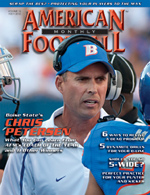AMERICAN FOOTBALL MONTHLY THE #1 RESOURCE FOR FOOTBALL COACHES
|
|
Article Categories
|
Speed Report: Cyclic Rhythm - The Transparent Component of Speed by: Dale BaskettFootball Speed Specialist© More from this issueSpeed training is such a vast subject. A relatively new area in the field is rhythm and speed development. The simple truth is that its values are off the chart for positive transformation of motor transition and nervous system adaptation.
Proper balance is a subject that pops up often in the sports training world when discussing running and movement. Balance can surely be enhanced; however rhythm is far more critical when velocity and limb frequency are engaged collectively.
The Significance of Rhythm
When you plug in a speed program, you usually consider the major elements such as power, force, frequency, mechanical efficiency, etc. Seldom do you hear about the rhythm component that must share the stage with the other elements I mentioned. The truth is that it should be cons....The full article can only be seen by subscribers.
Subscribe today!

|
|
|
NOT A SUBSCRIBER?
Subscribe
now to start receiving our monthly magazine PLUS get INSTANT
unlimited access to over 4000 pages of 100 percent football coaching
information, ONLY available at AmericanFootballMonthly.com!
|
|
|
HOME
|
MAGAZINE
|
SUBSCRIBE
|
ONLINE COLUMNISTS
|
COACHING VIDEOS
|
Copyright 2026, AmericanFootballMonthly.com
All Rights Reserved






